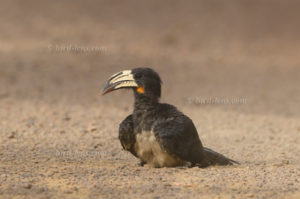 On the way back from the Campo Maan National Park after a very successful search for the Grey-necked Rockfowl (Picathartes oreas) we drive on the last day straight into a hollow and then look over a ridge, which makes the track in the slightly wavy national park. Before us, dust swirls in the middle of the dirt track. A group of African Pied Hornbills does not only just hang around in the adjacent trees, but also on the ground. The African Pied Hornbill (Tockus fasciatus) with their red lower bill belong to the subspecies fasciatus and they really look so beautiful. Although the track does not look too dusty, it seems to exert an uncanny attraction on the birds. Some individuals of the African Pied Hornbills are already flying away when we come over the top with our car. But one bird – probably a female – remains sitting and takes a long dusty bath. I let the driver stop the car and also turn off the engine. So, I can take some distance shots with the Canon EF400mm f / 2.8L IS II USM lapped on the side mirror. Then I let it get closer two more times. The bird does not fly off. Of course, the female of African Pied Hornbill does not let us out of her sight. First, she secures, but then she ducks deep into a hollow and throws up the dust so that the plumage is completely covered. Only when we are up to 25 meters, she flies out of the lying posture and disappears on a perch in a low tree. This day was almost the most successful birding morning of the last days.
On the way back from the Campo Maan National Park after a very successful search for the Grey-necked Rockfowl (Picathartes oreas) we drive on the last day straight into a hollow and then look over a ridge, which makes the track in the slightly wavy national park. Before us, dust swirls in the middle of the dirt track. A group of African Pied Hornbills does not only just hang around in the adjacent trees, but also on the ground. The African Pied Hornbill (Tockus fasciatus) with their red lower bill belong to the subspecies fasciatus and they really look so beautiful. Although the track does not look too dusty, it seems to exert an uncanny attraction on the birds. Some individuals of the African Pied Hornbills are already flying away when we come over the top with our car. But one bird – probably a female – remains sitting and takes a long dusty bath. I let the driver stop the car and also turn off the engine. So, I can take some distance shots with the Canon EF400mm f / 2.8L IS II USM lapped on the side mirror. Then I let it get closer two more times. The bird does not fly off. Of course, the female of African Pied Hornbill does not let us out of her sight. First, she secures, but then she ducks deep into a hollow and throws up the dust so that the plumage is completely covered. Only when we are up to 25 meters, she flies out of the lying posture and disappears on a perch in a low tree. This day was almost the most successful birding morning of the last days.
Campo Maan is Hornbill -Country with the possibility of White-crested Hornbill (Tockus albocristatus), Red-billed Dwarf Hornbill (Tockus camurus), African Pied Hornbill (Tockus fasciatus), Piping Hornbill (Ceratogymna fistulator), White-thighed Hornbill (Ceratogymna albotibialis) and the impressive Black-casqued Hornbill (Ceratogymna atrata) in a short trip.
The African Pied Hornbill is pretty much the most common and on first sight the most unspectacular. But if you can photograph the behavior of dust bathing, of course, this bird and its beauty appears in a new light.
One of the reasons for the two-week tour to Cameroon was to shoot much better shots of the Red-headed Picathartes, the very primitive-looking rainforest dwellers were already in April 2017 the main reason to pay a visit to the Campo Maan National Park.
The drive to Campo Maan National Park and back to “civilization” was tedious but ultimately successful. Overall, it can be said that the yield – even in comparison to the guided trip in April 2017 – can be seen in very good pictures.
Above all, Bird-lens.com is a website designed to meet the growing demand for top photos of Western Palearctic birds. In order to meet the overall growing demand for top photos of rare bird species, Bird-Lens.com has also made targeted trips to remote locations such as Africa or South America. All this to be able to take excellent photos of birds. The yield of pictures not only of rare Western Palearctic birds is very good. The beautiful picture of the blog is just a first impression, what you can find in the tab “Picture-Shop” very soon. Just leave a message if bird-lens.com can serve with a Picture.